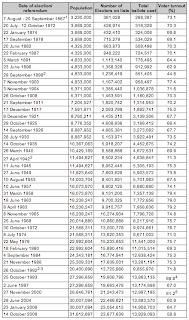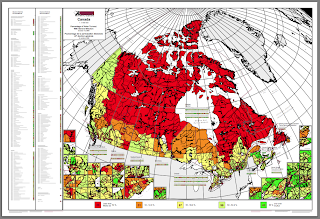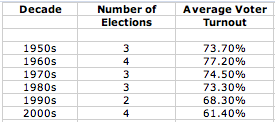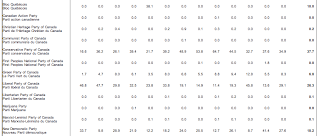Now that Canadians are being taken into those little cardboard voting booths again, I thought I’d take a look at voter turnout since Confederation. Fortunately, the information is readily available on the Elections Canada website.
There have been 43 elections and referendums since Confederation in 1867. Here’s a table showing the date of the election (note that early elections took place over a period of weeks or months), the population of Canada that year, the number of electors on the list, the total votes cast and the voter turnout as a percentage:
According to the Voter turnout hit a low of 44.6 percent for the referendum of September 29th, 1898. This is a wee bit misleading because this was a referendum rather than an election. As history goes, this referendum is rather interesting because it was held to determine whether Canada should impose Prohibition and it ended up being a turning point in the issue of the temperance movement in Canada. In this referendum, the Prohibition side won but Prime Minister Laurier refused the will of the people who voted 51 percent in favour of Prohibition because such a small majority of the total number of adult Canadians (51 percent of 44.6 percent) were actually in favour of Prohibition. It’s interesting to see how the Prime Minister of the day actually stepped in to overturn what a slim majority of voters wanted.
Back to the subject at hand. In regular elections, voter turnout hit a high of 79.4 percent in the election of March 31, 1958 and a low of 58.8 percent in the election of October 14, 2008. Here is a map from Elections Canada showing the percentage of voter turnout by riding for the 2008 election:
In 2008, the region with the highest overall voter turnout was Northern New Brunswick and Prince Edward Island. The province with the lowest voter turnout was Alberta, particularly the north and east portions of the province. I find this particularly interesting because Alberta is the home province to both the Reform/Conservative movement and Canada’s right-leaning Prime Minister.
While voter turnout in some elections during the 1890s and 1920s was in the mid- to low-60s, the trend of voter turnout since the 1980s has been strongly downward. Here’s a chart showing average voter turnout for all elections by decade since the 1950s:
There is no doubt that the trend of voter engagement in the process of electing Canada’s federal governments is headed lower, from a peak of 77.2 percent over 4 elections in the 1960s to a low of 61.4 percent in the new millennium. While many Canadians are griping because of the frequency of federal elections in the last decade (2000, 2004, 2006 and 2008), things were no better in the 1960s when four elections were held in the years 1962, 1963, 1965 and 1968. In fact, over a period of less than 10 months between June 18, 1962 and April 8, 1963, there were two elections and yet 79 percent of eligible voters exercised their franchise in both elections, among the highest in Canadian political history. I can hardly imagine that happening today.
According to the statistics, in the November 1988 election, 13.281 million Canadians voted out of a total country-wide population of 25.309 million with a total of 17.639 million eligible voters. In the October 2008 election, 13.929 million Canadians voted out of a total country-wide population of 31.612 million with a total of 23.678 million eligible voters. Despite the fact that over the 30 year period, the number of eligible voters rose by 6.039 million for an increase of 34.2 percent, only 648,000 additional Canadians participated in the voting process for a pathetically small increase of only 4.9 percent.
The problem with low voter turnout compounds when Canada has a succession of minority governments. Here is a tableshowing the Official Voting Results for the 2008 election by Party:
The Conservatives received 37.7 percent of the valid votes cast. Since only 58.8 percent of Canadians voted, they actually received the approval of only 22.2 percent of eligible Canadian voters and, with that insignificant approval rating, went on to form a minority government. The Liberals fared even worse; they received 26.3 percent of the valid votes cast, receiving the approval of a pitiful 15.4 percent of eligible Canadian voters.
When a Party can run Canada after receiving approval from well less than one-quarter of the country’s eligible voters, the political system is showing unmistakable signs of stress. Sure, we often hear the mantra "If you don’t vote, you can’t complain" but the unfortunate part of that is that it doesn’t matter whether we vote or not, our MPs and their leaders seem to develop a case of impaired hearing when they arrive on Parliament Hill. What is happening is that a subset of a minority of Canadians is ruling the country.
 I honestly don’t know how to solve the problem of low voter turnout. My suspicion is that a great deal of voter apathy can be attributed to the current leadership of both the Conservative and Liberal Parties. Mr. Ignatieff and Mr. Harper are hardly compelling public figures and perhaps that explains our disinterest; voters find Mr. Ignatieff uninteresting and find Mr. Harper frightening. Perhaps part of the apathy we feel is because we sense that it really doesn’t matter what we think, our elected officials will press forward with their agenda despite our protests. Perhaps we have become disillusioned about our country’s political process when we watch snippets of Question Period where we see grown men and women acting like elementary school children in a playground at recess (my apologies to elementary school children everywhere for the comparison) with the vague notion of scoring a few political points at the expense of the other. Perhaps its the "I must win so you must lose" mentality that has pervaded the House; rather than seeking compromise, MPs and Ministers seem to go out of their way to create controversy and dissent.
I honestly don’t know how to solve the problem of low voter turnout. My suspicion is that a great deal of voter apathy can be attributed to the current leadership of both the Conservative and Liberal Parties. Mr. Ignatieff and Mr. Harper are hardly compelling public figures and perhaps that explains our disinterest; voters find Mr. Ignatieff uninteresting and find Mr. Harper frightening. Perhaps part of the apathy we feel is because we sense that it really doesn’t matter what we think, our elected officials will press forward with their agenda despite our protests. Perhaps we have become disillusioned about our country’s political process when we watch snippets of Question Period where we see grown men and women acting like elementary school children in a playground at recess (my apologies to elementary school children everywhere for the comparison) with the vague notion of scoring a few political points at the expense of the other. Perhaps its the "I must win so you must lose" mentality that has pervaded the House; rather than seeking compromise, MPs and Ministers seem to go out of their way to create controversy and dissent. It is such a shame that Canadians are becoming increasingly disillusioned, disenfranchised and disappointed with Ottawa. More is the shame because it is our inattention to the political process that is allowing the federal governments of both major Parties to foist their disagreeable agendas on Canada in an attempt to remake the country in their own image.
In closing, I would ask one thing of Canadians. Please voters, pay attention to what is happening in Ottawa and involve yourself in the process and remember that Canada does not belong to any particular political party, politician or Prime Minister. Paying attention to our political process is the only way that we can keep our Canada from slipping away.
Click HERE to read more of Glen Asher’s columns.
Article viewed at: Oye! Times at www.oyetimes.com
You can publish this article on your website as long as you provide a link back to this page.





Useful information … however, too bad you dcomment_ID not include the comment_date of the 2011 election, given your intent to reflect voter apathy.